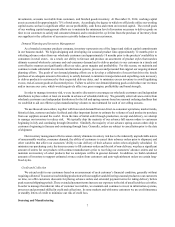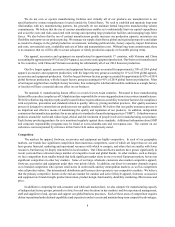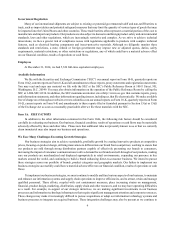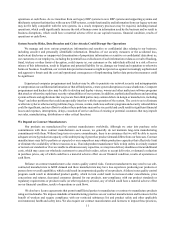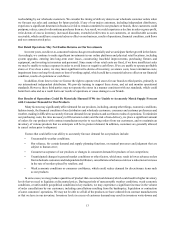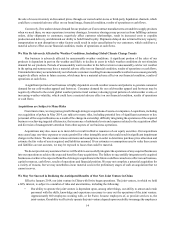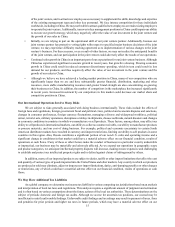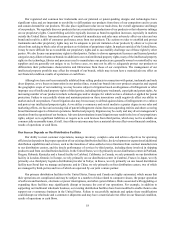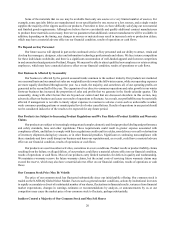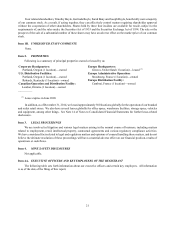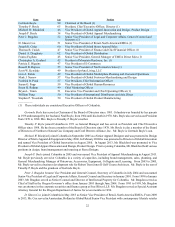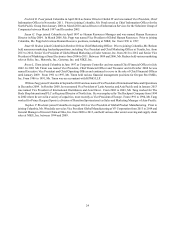Columbia Sportswear 2014 Annual Report Download - page 21
Download and view the complete annual report
Please find page 21 of the 2014 Columbia Sportswear annual report below. You can navigate through the pages in the report by either clicking on the pages listed below, or by using the keyword search tool below to find specific information within the annual report.17
Economic downturns and economic uncertainty generally affect global credit markets. Our vendors, customers and
other participants in our supply chain may require access to credit markets in order to do business. Credit market conditions
may slow our collection efforts as customers find it more difficult to obtain necessary financing, leading to higher than
normal accounts receivable. This could result in greater expense associated with collection efforts and increased bad debt
expense. Credit conditions may impair our vendors’ ability to finance the purchase of raw materials or general working
capital needs to support our production requirements, resulting in a delay or non-receipt of inventory shipments during key
seasons.
Historically, we have limited our reliance on debt to finance our working capital, capital expenditures and investing
activity requirements. We expect to fund our future capital expenditures with existing cash, expected operating cash flows
and credit facilities, but if the need arises to finance additional expenditures, we may need to seek additional funding. Our
ability to obtain additional financing will depend on many factors, including prevailing market conditions, our financial
condition, and our ability to negotiate favorable terms and conditions. Financing may not be available on terms that are
acceptable or favorable to us, if at all.
We May Be Adversely Affected by Retailer Consolidation
When our wholesale customers combine their operations through mergers, acquisitions, or other transactions, their
consolidated order volume may decrease while their bargaining power and the competitive threat they pose by marketing
products under their own private labels may increase. Some of our significant customers have consolidated their operations
in the past, which in turn has had a negative effect on our business. Future customer consolidations could have a material
adverse effect on our financial condition, results of operations or cash flows.
We Rely on Innovation to Compete in the Market for Our Products
To distinguish our products in the marketplace and achieve commercial success, we rely on product innovations,
including new or exclusive technologies, inventive and appealing design, or other differentiating features. Although we are
committed to designing innovative and functional products that deliver relevant performance benefits to consumers who
participate in a wide range of competitive and recreational outdoor activities, if we fail to introduce technical innovation in
our products that address consumers’ performance expectations, demand for our products could decline.
As we strive to achieve product innovations, we face a greater risk of inadvertent infringements of third party rights
or compliance issues with regulations applicable to products with technical innovations such as electrical heating components
and material treatments. In addition, technical innovations often involve more complex manufacturing processes, which
may lead to higher instances of quality issues, and if we experience problems with the quality of our products, we may incur
substantial expense to address the problems and any associated product risks. For example, in recent years we incurred
costs in connection with recalls of some of our battery-powered electrically heated apparel. Failure to successfully bring to
market innovations in our product lines could have a material adverse effect on our financial condition, results of operations
or cash flows.
We Face Risks Associated with Consumer Preferences and Fashion Trends
Changes in consumer preferences or consumer interest in outdoor activities may have a material adverse effect on
our business. In addition, changes in fashion trends may have a greater impact than in the past as we expand our offerings
to include more product categories in more geographic areas, particularly with the Sorel and prAna brands, which are
generally more sensitive to fashion trends. We also face risks because our business requires us and our customers to anticipate
consumer preferences. Our decisions about product designs often are made far in advance of consumer acceptance. Although
we try to manage our inventory risk by soliciting advance order commitments by retailers, we must generally place a
significant portion of our seasonal production orders with our contract manufacturers before we have received all of a
season’s advance orders from customers, and orders may be canceled by customers before shipment. If we or our customers
fail to anticipate and respond to consumer preferences, we may experience lower sales, excess inventories and lower profit
margins in current and future periods, any of which could have a material adverse effect on our financial condition, results
of operations or cash flows.
Our Success Depends on Our Use and Protection of Intellectual Property Rights


